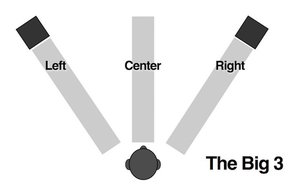- in Book Excerpt , Engineering , Production by Bobby Owsinski
When It Comes To Panning, Respect The Big 3

© 2016 Bobby Owsinski, All Rights Reserved.
One of the most overlooked or taken for granted elements in mixing is panorama, or the act of placing a sound element in the soundfield. To understand panorama we must first understand that the stereo sound system (which is two separate audio channels, each with its own speaker) represents sound spatially. Panning lets us select where in that space we place the sound.
In fact, panning does more than just that. Panning can create excitement by adding movement to the track and adding clarity to an instrument by moving it out of the way of other sounds that may be clashing with it. Correct panning of a track can also make a recording sound bigger, wider, or deeper, sometimes all at the same time.
In this excerpt from the 4th edition of The Mixing Engineer’s Handbook, we look at the three major panoramic areas in a mix, the extreme hard left, the extreme hard right, and the center (see the graphic), that must be respected.
The center is obvious in that the most prominent music element (like the lead vocal) is usually panned there, but so is the kick drum, bass guitar, and even the snare drum. Although putting the bass and kick up the middle makes for a musically coherent and generally accepted technique, its origins come really from the era of vinyl records.
With the first stereo recordings in the mid-’60s, sometimes the music from the band was panned to one channel while the vocals were panned to the opposite one. This was because stereo was so new that the recording and mixing techniques for the format hadn’t been refined yet, so what we now know as pan pots weren’t available on mixing consoles. Instead, a three-way switch was used to assign the track to the left output, the right output, or both (the center). Sometimes the channels were even dedicated to either left or right, like on the famous REDD console at Abbey Road Studios that was used to record The Beatles and other major acts of the day.
Because music elements tended to be hard panned to one side, this caused some major disc-cutting problems in that if any low-frequency boost was added to the music on just that one side, the imbalance in low-frequency energy would cause the cutting stylus to cut right through the groove wall when the master lacquer disc (the master record) was cut. The only way around this was to either decrease the amount of low-frequency energy from the music to balance the sides or pan the bass and kick and any other instrument with a lot of low-frequency information to the center. In fact, a special equalizer called an Elliptical EQ was used during disc cutting specifically to move all the low-frequency energy from both sides to the center to prevent any cutting problems.
Likewise, as a result of the vast array of stereo and pseudo-stereo sources and effects that came on the market over the years, mixers began to pan these sources hard left and right almost without even thinking, since a mixer’s main task is to make things sound bigger and wider. Suddenly things sounded huge! The problem came later, when almost all keyboards and effects devices came with stereo outputs (many are actually pseudo-stereo with one side just chorused a little sharp and then flat against the dry signal). Now the temptation was to pan all of these “stereo” sources hard left and right on top of one another. The result was “Big Mono.”
“I think that there are three sacred territories in a mix that if you put something there, you’ve got to have an incredibly good reason. That’s extreme left, the center, and extreme right. I’ve noticed that some mixers will get stereo tracks from synthesizers and effects, and they just instinctively pan them hard left and hard right. What they end up with is these big train wrecks out on the ends of the stereo spectrum. Then they pan their kick, snare, bass, and vocals center, and you’ve got all this stuff stacked on top of each other. If it were a visual, you wouldn’t be able to see the things behind the things in front.”
—Dave Pensado
You can read more from The Mixing Engineer’s Handbook and my other books on the excerpt section of bobbyowsinski.com.

